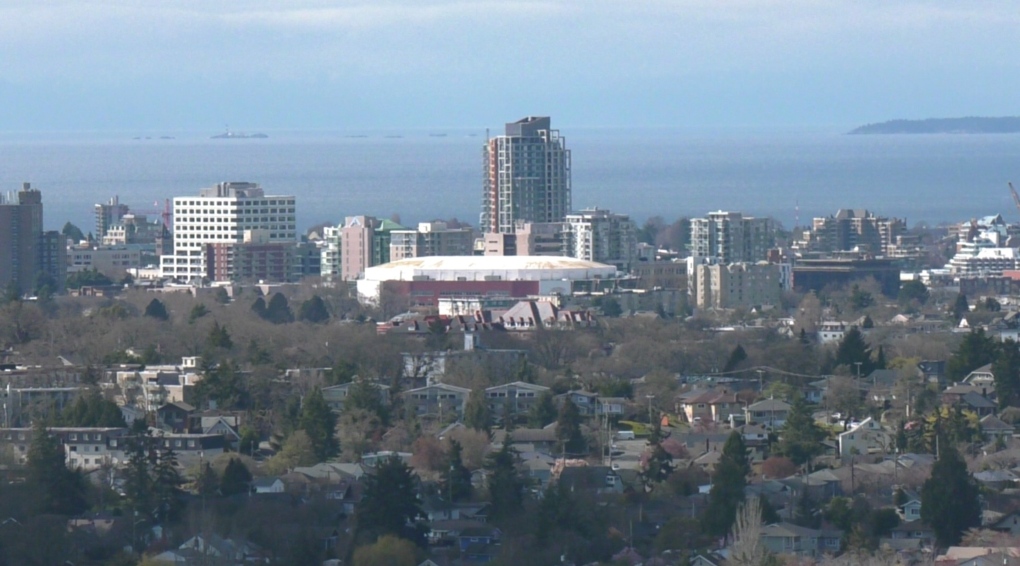Victoria in 'dire need of rental housing' as vacancy rate drops: CMHC
 A view of downtown Victoria from Mt. Tolmie. (CTV News)
A view of downtown Victoria from Mt. Tolmie. (CTV News)
Greater Victoria's rental housing market tightened in 2021, returning to pre-pandemic vacancy rates below those of Greater Vancouver, according to the latest rental market report from the Canada Mortgage and Housing Corporation.
Record migration to British Columbia, coupled with a recovering local job market, sent demand for new units and bachelor suites especially high, even as prices continued to climb, according to CMHC analysts.
Households earning less than $42,000 annually cannot affordably rent a bachelor suite, as rental prices remain at least $350 per month higher than their affordability rate, according to the report.
Similarly, those earning $64,000 or less would have to spend at least $400 per month more for a two-bedroom unit than what is considered affordable. The vacancy rate for affordable two-bedroom units was approximately 0.2 per cent last year.
"The majority of rental households, especially low-income households, remain in dire need of affordable and suitable rental housing," the report found.
VACANCY RATES
The regional vacancy rate declined from 2.2 per cent in 2020 to one per cent in 2021, while the vacancy rate in areas like the West Shore communities fell to 0.4 per cent last year from two per cent in 2020. By comparison, Greater Vancouver's vacancy rate was 1.2 per cent last year, according to the report.
The supply of new rentals in Greater Victoria dwindled in 2021 compared to 2020, especially in the city's urban core.
Across the region, the vacancy rate for two-bedroom units was 0.8 per cent in 2021, and the vacancy rate for new rentals (completed after 2018) was 0.5 per cent, according to the federal housing corporation.
The CMHC says the average two-bedroom rental cost last year was $1,571, an increase of 3.1 per cent. However, prices for vacant units were $300 to $400 more expensive than occupied units, discouraging long-term renters from moving, according to the CMHC.
MIGRATION AND JOB MARKET
Between July 2020 and June 2021, more Canadians moved to B.C. than anywhere else in the country, according to the CMHC.
There was a net inflow of over 34,000 people last year, a record high since 1994. Many post-secondary students also returned to campuses, creating more demand for rental housing, the corporation added.
Meanwhile, the capital region added 5,600 jobs between January and November 2021, with 80 per cent of those being full-time employment.
The unemployment rate for 15 to 24 year old renters returned to pre-pandemic levels, while the hard-hit hospitality sector recovered about half of the jobs lost in 2020, according to the report.
RENTAL SUPPLY SLOWS
Victoria's supply of purpose-built rentals grew by 660 units last year, which was roughly half of what was added in 2020, according to the CMHC.
That new rental supply was found only in a few areas, the CMHC noted, particularly in Saanich and the West Shore. Among new units completed since 2018, more than half were in the West Shore.
"With demand resuming and supply growth slowing, Victoria could see additional tightening in the rental market," the CMHC report warned. "The majority of rental households, especially low-income households, remain in dire need of affordable and suitable rental housing."
CTVNews.ca Top Stories

Finland stops Russia-linked vessel over damaged undersea power cable in Baltic Sea
Finnish authorities detained a ship linked to neighboring Russia as they investigate whether it damaged a Baltic Sea power cable and several data cables, police said, in the latest incident involving disruption of key infrastructure.
DEVELOPING Body found in wheel well of plane at Maui airport
A person was found dead in the wheel well of a United Airlines flight to Maui on Tuesday.
Raised in Sask. after his family fled Hungary, this man spent decades spying on communists for the RCMP
As a Communist Party member in Calgary in the early 1940s, Frank Hadesbeck performed clerical work at the party office, printed leaflets and sold books.
Aviation experts say Russia's air defence fire likely caused Azerbaijan plane crash as nation mourns
Azerbaijan on Thursday observed a nationwide day of mourning for the victims of the plane crash that killed 38 people and left all 29 survivors injured as speculation mounted about a possible cause of the disaster, with some experts saying that the airliner was damaged by Russian air defence fire.
Bird flu, measles top 2025 concerns for Canada's chief public health officer
As we enter 2025, Dr. Theresa Tam has her eye on H5N1 bird flu, an emerging virus that had its first human case in Canada this year.
Police identify victim of Christmas Day homicide in Hintonburg, charge suspect
The Ottawa Police Service says the victim who has been killed on Christmas Day in Hintonburg has been identified.
Your kid is spending too much time on their phone. Here's what to do about it
Wondering what your teen is up to when you're not around? They are likely on YouTube, TikTok, Instagram or Snapchat, according to a new report.
Ship remains stalled on St-Lawrence River north of Montreal
A ship that lost power on the St. Lawrence River on Christmas Eve, remains stationary north of Montreal.
Christmas shooting at Phoenix airport leaves 3 people wounded
Police are investigating a Christmas shooting at Sky Harbor Airport in Phoenix that left three people injured by gunfire.
































